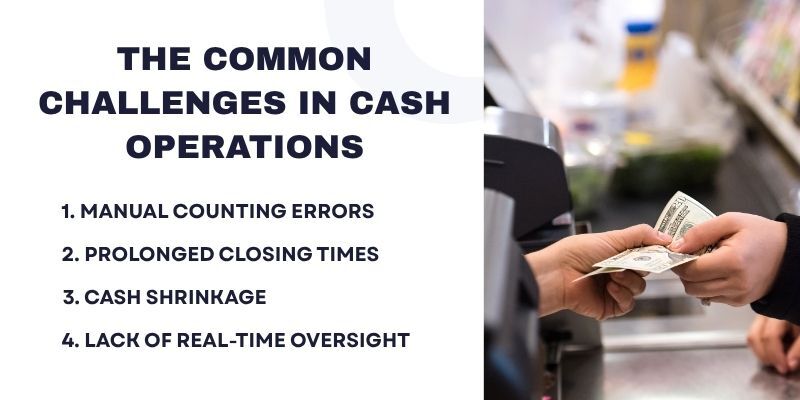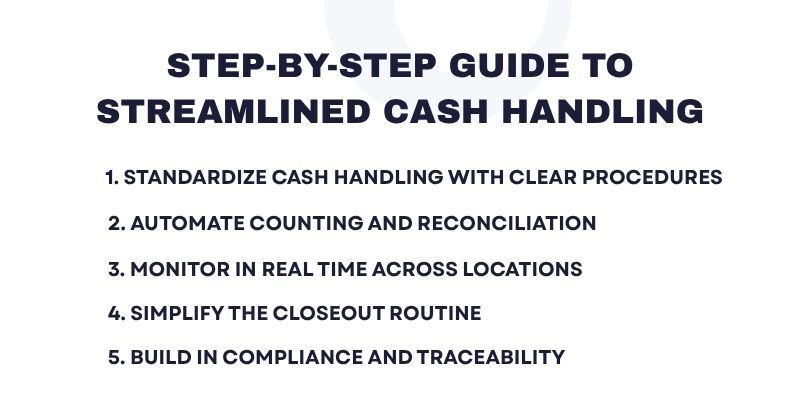It’s closing time at a busy retail store. As the last few customers check out, a tired cashier begins sorting through bills and coins. In the back office, a manager braces for another late night spent reconciling mismatched totals.
These scenes play out daily in retail outlets and bank branches where cash transactions still dominate.
Manual processes, long queues, and end-of-day balancing delays don’t just slow things down. They create pressure, introduce errors, and make it harder to maintain accountability.
That’s why knowing how to streamline cash operations isn’t only helpful, but also essential. Businesses need reliable systems that reduce errors, improve oversight, and help teams close out with confidence.
This blog addresses the most common challenges in cash handling, provides strategies to digitize daily routines, and shares practical methods to enhance end-of-day balancing.
We’ll also highlight performance metrics that help measure success and support stronger operational control.
The Common Challenges in Cash Operations

Manual cash handling can seem like a routine task, but its hidden costs are often underestimated. For many businesses, the process involves more than just counting bills and coins. It affects speed, accuracy, and labor efficiency at nearly every stage of daily operations.
Here are the most common cash-handling challenges and how they impact performance:
1. Manual counting errors:
Even the most careful staff can miscount under pressure. Small errors in cash drawers can lead to bigger reconciliation problems later in the day, affecting both accuracy and customer trust. This is a major reason why end-of-day cash balancing often takes longer than it should.
2. Prolonged closing times:
Without a streamlined process, staff may spend 30 to 60 minutes after closing reconciling cash. According to data from Brink’s, employees managing low volumes of cash spend an average of 15 hours per month on manual cash-related tasks. That number increases to 48 hours for businesses with high cash volumes.
3. Cash shrinkage and lack of accountability:
When responsibility is spread across multiple team members, tracking discrepancies becomes difficult. This not only increases the risk of shrinkage but also complicates internal audits. Manual cash handling has a greater impact on retailers than most, as high transaction volumes amplify these risks.
4. Lack of real-time oversight:
Most traditional systems offer little visibility into cash positions during the day. This makes it difficult to forecast cash needs, spot errors quickly, or detect patterns that could indicate fraud or inefficiency.
These issues create operational drag and chip away at profitability. Manual balancing, tracking down cash discrepancies, and end-of-day reconciliation leave staff exhausted and increase the risk of human error.
Over time, this slows down operations and reduces overall efficiency. Smart cash solutions help streamline these repetitive tasks, allowing teams to focus more on service, security, and delivering a better customer experience.
Why Digital Methods Matter for End-of-Day Balancing
At the end of a busy shift, every minute matters. Staff are fatigued, customers may still be waiting, and managers face increasing pressure to close out quickly without mistakes.
Digital counters reduce counting errors by instantly validating bills and coins and flagging mismatches in real-time.
When linked with POS systems, automated cash reconciliation ensures every sale aligns with the physical drawer total, eliminating manual entry and simplifying the closing process.
This is essential for POS cash balancing in retail, where even minor discrepancies can delay store closings and complicate audits.
Real-time dashboards reveal till floats, deposit activity, and variances across locations. That visibility helps prevent issues from escalating and supports a smoother retail customer experience, even during peak hours.
In 2025, Marks & Spencer faced similar challenges after expanding its payment options. Their finance team struggled to reconcile high transaction volumes across multiple systems.
To address this, the company reassessed its reconciliation structure, shifting from regional to store-level reconciliation. This enabled teams to identify discrepancies more quickly and trace them to specific locations or banks.
Their new system now processes over 20,000 weekly entries across five data feeds, matching sales and refunds by card type against incoming bank statements. Delayed bank credits are flagged and addressed promptly, helping prevent losses and improving accuracy.
A custom integration with American Express’ EPA platform also enabled daily store-level matchbacks, giving the team greater precision and control.
Helen Davies, Project Manager at M&S, said: “We are more in control of the information and payments from the bank. Timely reporting enables checking of bank credits, which means late credits are acted upon and we don’t lose out on interest.”
By improving visibility and shifting from a reactive to an investigative approach, M&S was able to reduce errors, recover interest, and build a more agile reconciliation process.
This example shows how automation paired with strategic restructuring can unlock meaningful improvements in retail finance.
Step-by-Step Guide to Streamlined Cash Handling

Getting cash operations right isn’t just about speeding up the end-of-day close. It’s about removing friction from daily routines, eliminating avoidable errors, and ensuring that every dollar is accurately tracked from start to finish.
For teams in retail, banking, QSR, or service environments, combining structured processes with reliable systems brings measurable gains in efficiency, accuracy, and control.
1. Standardize Cash Handling with Clear Procedures
Standard operating procedures bring much-needed consistency across shifts, staff, and store locations.
When frontline teams have clear steps to follow, whether for verifying float amounts, sealing deposits, or recording reconciliation outcomes, they spend less time second-guessing and more time following through.
Clear sign-off protocols and variance thresholds reduce subjectivity and help staff avoid common errors. In high-volume locations, pairing frontline cash handlers with a supervisor for end-of-shift reconciliation ensures accuracy while creating accountability.
A simple rule, such as “tills must reconcile with POS totals within five minutes of shift close,” can reduce delays and maintain consistent operations across branches.
2. Automate Counting and Reconciliation
Manual counting is a frequent source of delays and errors. Automated deposit systems remove those risks and help teams focus on higher-value tasks.
Smart devices, such as cash deposit machines (CDMs), instantly count, validate, and secure incoming cash at the end of each shift, while syncing totals with backend systems for faster, error-free reconciliation.
Bank Alfalah, one of Pakistan’s largest private banks, deployed Wavetec’s CQuick cash deposit machines across more than 200 branches. Each machine supports bulk deposits of up to 500 notes, biometric KYC, facial recognition, and multilingual user interfaces.
These features helped drive widespread adoption, especially among women, who accounted for 25% more usage due to privacy and ease of access.
The results were clear. Bank Alfalah experienced a substantial increase in self-service transactions, resulting in improved service speed and a time-saving benefit for both customers and staff.
With 24/7 coverage and safer, contactless interactions, the new CDMs proved valuable, especially after hours.
3. Monitor in Real Time Across Locations
For cash operations managers overseeing multiple branches, live oversight is essential. Dashboards that offer real-time visibility into cash drawer activity, float usage, and reconciliation status remove the delays caused by waiting for end-of-day reports.
With platforms like Wavetec’s Spectra, managers can track variances, overages, and shortages as they happen, whether in a single location or across an entire region.
If a specific site runs low on float mid-shift or shows repeated reconciliation gaps, managers can respond immediately by adjusting staffing or reallocating funds.
The ability to access this data remotely is especially valuable for district leads who need to monitor multiple stores without being physically present. These capabilities turn cash monitoring into a live, proactive part of operations, rather than a delayed, reactive task.
4. Simplify the Closeout Routine
A digital workflow shortens the closeout routine while increasing accuracy:
- Step 1: Count cash using a smart device.
- Step 2: Auto-compare results with POS totals.
- Step 3: Flag any discrepancies for review.
- Step 4: Apply digital approval and submit.
This structure saves 15-30 minutes per store daily and reduces end-of-shift fatigue. In multi-location operations, these time savings add up quickly, freeing teams to focus more on customer interactions and less on paperwork.
For QSRs and fast-paced retail settings, where end-of-shift fatigue is prevalent, an efficient closing process has a direct impact on staff morale and the overall customer experience.
5. Build in Compliance and Traceability
Audit-readiness starts with clean, traceable records. Digital cash handling systems log every transaction in real-time, including who performed it, when it was done, and why.
This level of visibility makes it easier for managers and finance teams to investigate variances and ensure that nothing is missed quickly.
Automated logging eliminates the need to rely on handwritten notes or scattered spreadsheets. Version control and exception reports further reduce the burden on staff by flagging irregularities as they happen, not after the fact. This maintains audit trails without adding extra administrative work.
And this level of automation is no longer optional. According to Accenture, organizations that automate up to 80% of their finance operations, including cash management, closing the books, and error handling, are better positioned to expand automation into compliance and internal controls.
In short, automation not only improves speed but also builds a stronger foundation for financial accountability.
Essential KPIs for Cash Management Success

For operations and finance leaders, cash handling performance can’t be measured by gut feel. It requires tracking the right indicators, especially as cash digitization accelerates across retail and service sectors.
Metrics must reflect how efficiently staff close out, how often discrepancies occur, and how well procedures are followed across locations.
Strong digital cash management strategies are only as effective as the metrics that support them. These four KPIs offer a focused starting point:
1. EOD Closing Time
This KPI measures the time it takes to complete cash reconciliation after store closing. Longer durations often point to manual processes, unclear handoffs, or hardware slowdowns.
If reconciliation regularly extends past shift end, it affects labor costs and delays reporting for regional teams.
2. Cash Variance Rate
Variance refers to the difference between recorded sales and the actual cash counted at the end of the day. High variance can signal process errors, inconsistent float handling, or a lack of standardization across shifts.
Regularly tracking this rate helps spot problem locations and reduce unexplained losses.
3. Shrinkage Events
These are occurrences where cash goes missing or shortages are reported without explanation. Monitoring the frequency of such events helps identify patterns, whether due to human error, process breakdowns, or theft. It also provides early indicators for deeper compliance reviews.
4. Compliance Rate
This KPI measures the consistency with which frontline staff adhere to cash handling SOPs, including the timing of deposits, required approvals, and dual-control procedures.
A drop in compliance often precedes higher variances or delays in reconciliation. Tracking adherence across stores ensures policies aren’t just documented; they’re practiced.
Best Practices & Pitfalls to Avoid
Cash handling is often consistent in theory but inconsistent in execution. To build accountability into daily routines, leaders must combine clear standards with systems that support repeatable processes.
Below is a table of proven practices and common missteps that affect both reconciliation speed and accuracy:
| Do This | Avoid This |
|---|---|
| Train staff quarterly to reinforce SOPs and account for policy updates, seasonal staff changes, and new system rollouts. | Relying on one-time training leaves teams unprepared for edge cases or process changes. |
| Set variance thresholds per location and shift type to flag patterns early and enable faster investigations. | Treating every variance equally wastes time and hides locations with chronic issues. |
| Use a closing checklist built into your POS or reconciliation platform to prompt required actions in real time. | Manual spreadsheet tracking increases the risk of errors and slows down audits. |
| Enforce consistent handoff routines between shifts to maintain accountability over float and counted cash. | Letting stores set their own cash policies creates gaps and inconsistencies across locations. |
| Reconcile on the same day to catch discrepancies while details are fresh and correctable. | Delaying reconciliation until the next day weakens audit trails and increases shrink risk. |
How to Get Started with Digital Cash Management
Begin by auditing your current cash-handling workflow. Map each step from cash pickup to deposit to identify where delays, errors, or manual handoffs occur. This diagnostic phase helps benchmark performance and spot operational gaps.
Next, assess your hardware and software options. Whether you’re considering a POS-integrated cash deposit machine or a standalone CDM, focus on ease of integration, scalability, and user experience. The benefits of CDMs include secure storage, faster reconciliation, and fewer discrepancies.
Once the tools are selected, pilot the solution in a high-volume location. Track its impact on reconciliation speed, variance rates, and labor hours. Use those insights to create SOPs for deposit timing, exception handling, and approvals.
Providers like Wavetec offer modular systems designed for both retail and banking environments. Their platforms support ERP integration, closed-loop reconciliation, and are built for frontline usability, helping organizations scale digital cash management confidently.
After finalizing your protocols, roll out the solution across other locations and connect it to your ERP or finance stack for consistent visibility and control.
Conclusion
Manual cash handling consumes time, increases risk, and makes it more challenging to maintain control. End-of-day fatigue slows down reconciliation, allowing small discrepancies to accumulate, which in turn impact compliance, visibility, and overall performance.
Improving cash handling efficiency starts with removing guesswork. Digital systems reduce manual steps, standardize processes across locations, and help teams close with accuracy and speed.
To move forward, begin by reviewing your current workflows. Identify bottlenecks, choose solutions that align with your environment, and roll them out in manageable phases.
Small, well-executed changes can deliver stronger control, faster closings, and better decision-making across the board.
BOOK A FREE DEMO


